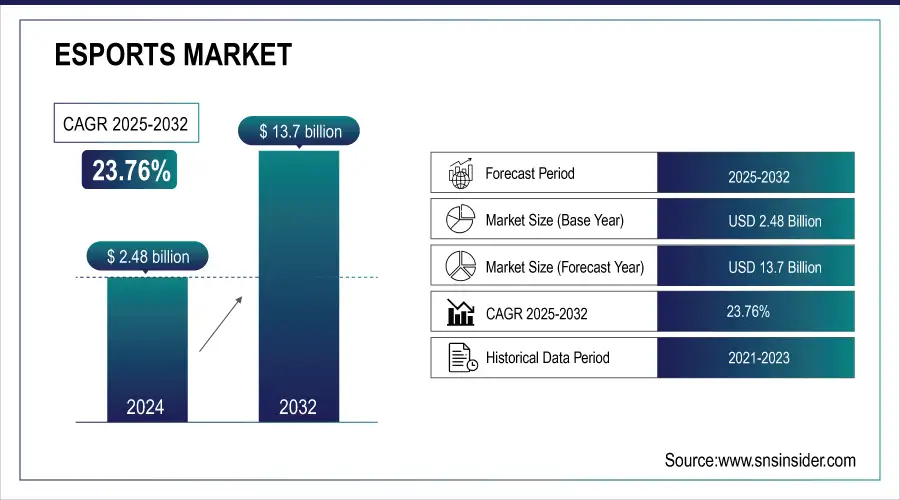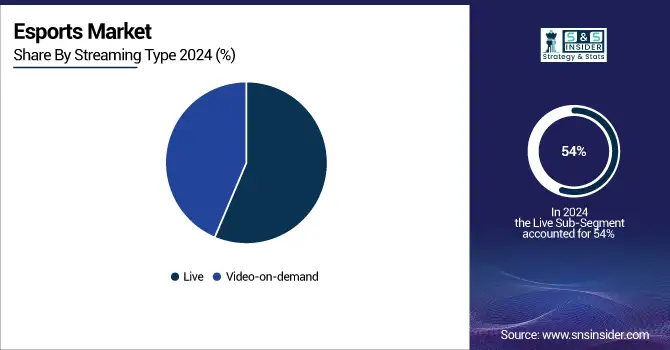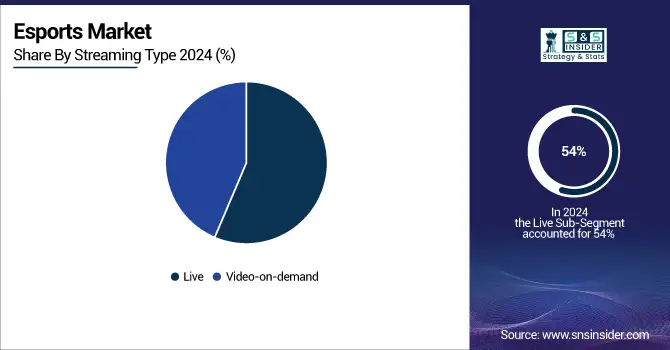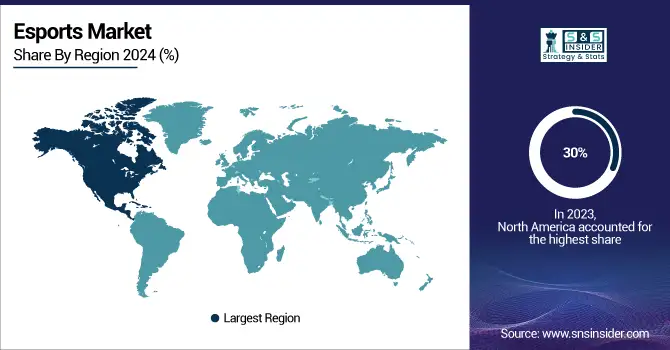The Esports Market Report Scope & Overview:
The Esports Market was valued at USD 2.48 billion in 2024 and is expected to reach USD 13.7 billion by 2032, growing at a CAGR of 23.76% from 2025-2032.

Get More Information on Esports Market - Request Sample Report
Key Trends Shaping the Esports Market
-
Rapid Audience Growth: Increasing global interest in competitive gaming drives higher viewership, sponsorships, and investments in tournaments, streaming platforms, and fan engagement initiatives.
-
Sponsorship & Advertising Expansion: Brands are actively investing in esports sponsorships, influencer partnerships, and digital campaigns, boosting revenue streams and market visibility.
-
Platform & Streaming Innovations: Advancements in live streaming, cloud gaming, and interactive broadcasting enhance accessibility, user engagement, and monetization opportunities for esports content.
-
Professionalization & League Development: Structured leagues, franchised teams, and standardized regulations support sustainable growth, talent development, and long-term competitive integrity.
-
Technological Integration: Use of AI, analytics, and VR/AR improves player performance, fan experience, and tournament management efficiency.
-
Fragmented Competitive Landscape: The market remains highly competitive, with global esports organizations, platforms, and regional specialists expanding via partnerships, acquisitions, and sponsorship deals.

Esports Market Drivers:
-
Major brands invest heavily, with sponsorships contributing to nearly 60% of total revenue.
-
5G, VR, and other tech innovations enhance gaming experiences and fan engagement.
-
Platforms like Twitch and YouTube Gaming boost engagement and accessibility.
Platforms like Twitch and YouTube Gaming have played a crucial role in boosting engagement and accessibility in the esports market. These platforms provide gamers, teams, and tournaments a space to stream live events, allowing millions of viewers worldwide to watch competitions in real time. The accessibility of these platforms is key, as they enable anyone with an internet connection to follow their favorite esports events and players from anywhere in the world. This has expanded the esports audience far beyond traditional sports boundaries.
Twitch, in particular, has become synonymous with live gaming content, offering interactive features like live chats that create a community atmosphere, where fans can engage with streamers and other viewers during events. YouTube Gaming, with its vast reach and video-on-demand features, allows fans to catch up on missed events or highlights, making esports more accessible to a broader audience.
Both platforms also help promote smaller tournaments and amateur players, providing them with visibility and opportunities to grow. This increased engagement drives higher viewership numbers and sponsorships, which are key revenue streams for the esports industry. By democratizing access to live content, Twitch, and YouTube Gaming have become central to the rapid growth and popularity of esports worldwide.
Esports Market Restraints:
-
Esports platforms are vulnerable to hacking, cheating, and data breaches, which can damage reputation and trust.
-
Difficulties in consistently monetizing esports content, especially for smaller tournaments or teams.
-
Setting up professional esports arenas and high-end gaming setups can be expensive, limiting access.
Setting up professional esports arenas and high-end gaming setups is costly, which limits access for both players and organizers in the esports market. Building dedicated arenas for large-scale tournaments requires significant investment in infrastructure, including state-of-the-art gaming systems, high-speed internet, broadcasting equipment, and seating arrangements for live audiences. These high costs are a barrier, especially for smaller organizations or regions with fewer resources, restricting the expansion of esports events in certain markets. For players and teams, high-end gaming setups are essential for competitive performance. Professional-grade equipment, such as gaming PCs, monitors, and peripherals, is expensive, and constant updates are required to keep up with the rapidly advancing technology. This can be a financial strain, particularly for amateur or aspiring players, limiting their ability to train at a competitive level.
Additionally, the maintenance and operation costs of these facilities and setups add ongoing financial pressure. These expenses can deter potential investors or event organizers from entering the market, slowing down the growth of esports in less developed regions. While larger organizations and major cities can afford these investments, high costs present a significant restraint on the broader accessibility and expansion of the esports market globally.
Esports Market Segmentation Analysis:
-
By Streaming Type, Live Streaming Dominates Esports Market, With Video-on-Demand Gaining Momentum
The live segment dominated the market and represented over 54% of the revenue share in 2024. The live segment of the esports market is crucial for driving growth, largely because of the immersive and interactive experience it provides during live events. The combination of in-person tournaments and live streaming on platforms like Twitch and YouTube Gaming fosters real-time engagement, drawing millions of viewers worldwide. The appeal of live broadcasts lies in the immediacy and excitement of watching high-stakes competitions unfold in real-time, which in turn drives larger audiences and sponsorship investments.
Video-on-demand (VoD) is expected to grow significantly in CAGR during the forecast period. VoD services allow fans to watch esports content, such as live streams, tournaments, and highlights, at their convenience rather than being restricted to live broadcasts. This flexibility helps cater to diverse global audiences across different time zones, boosting viewership numbers and expanding the market. The popularity of platforms like YouTube Gaming and Twitch, which offer extensive VoD libraries, contributes to this growth.

-
By Revenue Source, Sponsorship Leads Esports Market Revenue, While Media Rights Drive Future Growth
In 2024, the sponsorship segment dominated the market and accounted for over 39.9% of global market revenue, as brands leveraged esports to connect with potential customers via online and offline channels. Through booths, interactive ads, posters, giveaways, and video displays, brands can creatively engage their target audience. Major companies like Nvidia, Red Bull, BMW, Coca-Cola, and the U.S. Air Force have already partnered with esports leagues and teams. As competition intensifies in the sponsorship space, brands are increasingly turning to esports and gaming to stand out and create authentic connections with their audiences.
The media rights segment is expected to grow at the highest CAGR of over 24.1% during the forecast period, positioning it as a major revenue driver. Media rights include payments made to teams, leagues, and event organizers for the rights to broadcast esports content. With numerous leagues, championships, and events regularly streamed on various platforms, this segment is expected to generate substantial revenue. Twitch Interactive, Inc. stands out as a leading platform for live streaming, where fans frequently tune in to watch major esports tournaments.
-
By Gaming Genre, First-Person Shooter Games Dominate Esports Market, MOBA and Fighting Games Witness Rapid Growth
In 2024, The first-person shooter (FPS) games segment dominated the market and represented over 39.2% of the market share, driven by a wide array of offerings from game developers and the games' realistic 3D environments. Meanwhile, the fighting games segment is also projected to experience notable growth, fueled by their increasing popularity in the virtual gaming world.
The multiplayer online battle arena (MOBA) games segment is anticipated to experience significant growth due to its varied and competitive gameplay. New trends, such as cross-platform play, allow players on various devices to compete together, while the rise of mobile MOBA games capitalizes on the widespread use of smartphones. Advances in AI and machine learning are enhancing gameplay, and the integration of virtual reality is providing a more immersive experience. These developments are set to drive significant growth in the esports market.
Esports Market Regional Analysis:
-
North America Esports Market Insights
In 2024, North America dominates the Esports Market with an estimated share of 30%, driven by high internet penetration, advanced gaming infrastructure, and strong sponsorship investments. The region benefits from a mature gaming ecosystem, widespread adoption of competitive gaming, and technological innovations such as cloud gaming and streaming platforms, supporting extensive deployment of esports events, leagues, and tournaments that enhance engagement, monetization, and market growth.

Need any customization research on Esports Market - Enquiry Now
-
United States Leads Esports Market in North America
The U.S. dominates with the largest market share, supported by a highly developed gaming industry, strong corporate sponsorships, and extensive media coverage. Major platforms like Twitch, YouTube Gaming, and professional esports leagues contribute to audience growth, while government support for digital entertainment and technological innovation further strengthens market expansion. The U.S.’s combination of high consumer spending, robust esports ecosystem, and innovation leadership reinforces its dominance in North America.
-
Asia Pacific Esports Market Insights
Asia Pacific is the fastest-growing region with an estimated CAGR of 14.6% in 2024, driven by expanding smartphone and internet access, government support for digital entertainment, and increasing esports adoption. Rising cybercafés, mobile gaming, and competitive tournaments accelerate market growth as consumers engage in accessible, high-quality gaming experiences, fostering regional esports ecosystems.
-
China Leads Esports Market Growth in Asia Pacific
China dominates the regional market due to massive mobile and PC gamer populations, government support for esports development, and large-scale tournaments. Investment in streaming platforms, esports infrastructure, and professional leagues drives participation and monetization. China’s growing esports audience, combined with high digital engagement and sponsorship opportunities, positions the country as a key driver of regional esports market growth.
-
Europe Esports Market Insights
In 2024, Europe holds a significant share in the Esports Market, driven by the increasing popularity of competitive gaming, esports tournaments, and youth engagement. Government support, investment in digital infrastructure, and growing sponsorship activities contribute to steady regional growth, fostering esports adoption across diverse countries and platforms.
-
United Kingdom Dominates Europe’s Esports Market
The U.K. leads Europe due to its strong gaming culture, early adoption of streaming platforms, and professional esports leagues. Government incentives for digital media, coupled with corporate sponsorships, encourage tournament organization, technological innovation, and fan engagement, supporting steady market expansion.
-
Latin America and Middle East & Africa Esports Market Insights
The Esports Market in Latin America and MEA is witnessing steady growth, fueled by rising internet penetration, growing smartphone usage, and expanding gaming communities. Investment in esports tournaments, gaming cafes, and mobile gaming infrastructure accelerates adoption, while government initiatives support digital entertainment development.
-
Regional Leaders in Latin America and MEA
Brazil leads Latin America due to its large gaming population, high mobile penetration, and increasing corporate sponsorship of esports events. In the Middle East & Africa, the UAE dominates, supported by government initiatives promoting digital entertainment, luxury esports arenas, and investments in professional gaming leagues.
Competitive Landscape Esports Market:
Nintendo
Nintendo is a global leader in the video game industry, renowned for its innovative hardware and iconic franchises such as Super Mario, The Legend of Zelda, and Pokémon. Established in Japan, the company has shaped modern gaming through consoles like the Nintendo Switch, which blends handheld and home gaming experiences. Nintendo focuses on family-friendly entertainment, creativity, and immersive storytelling. Its commitment to innovation and engaging gameplay continues to make it one of the most influential gaming companies worldwide.
-
In April 2025, Nintendo highlighted its esports initiatives during a Nintendo Switch 2 Direct event, introducing new IPs and enhancing Splatoon with esports features like improved matchmaking and live streaming integration. This expansion aims to tap into the growing competitive gaming market, strengthening Nintendo's position in esports through strategic partnerships and global audience engagement.
Modern Times Group (MTG)
Modern Times Group (MTG) is a Sweden-based digital entertainment company specializing in esports and gaming. The company operates leading esports platforms such as ESL and DreamHack, hosting international tournaments and leagues that attract millions of viewers. MTG also invests in game development and publishing, expanding its global footprint. By leveraging digital-first strategies, MTG creates interactive experiences that connect audiences, players, and brands. Its strong presence in esports makes it a pivotal force in shaping competitive gaming and online entertainment ecosystems.
-
In April 2025, Modern Times Group (MTG) announced the acquisition of Plarium, a leading gaming studio. This strategic move aims to strengthen MTG's position in the gaming industry by expanding its portfolio and enhancing its direct-to-consumer platform, Plarium Play.
Gameloft
Gameloft is a leading mobile game developer and publisher, recognized for creating immersive titles across genres such as racing, action, and simulation. Founded in 1999, the company has built a strong reputation with games like Asphalt, Dungeon Hunter, and Modern Combat. Gameloft focuses on delivering engaging experiences across smartphones, tablets, and digital platforms. With a global audience, it blends innovation, graphics, and gameplay to maintain its position as a top mobile gaming studio, collaborating with major entertainment brands for licensed games.
-
In March 2025, Gameloft launched a new mobile esports platform for Asphalt 9: Legends, focusing on community-driven tournaments and competitive play. This initiative aims to enhance the mobile esports ecosystem and attract a larger audience by offering regular in-app events, live streaming, and player rewards.
Esports Market Companies:
-
Riot Games
-
Tencent
-
Epic Games
-
Valve Corporation
-
Microsoft
-
NVIDIA
-
AMD
-
Corsair
-
ASUS
-
Intel
-
Logitech
-
Twitch Interactive
-
YouTube Gaming
-
FACEIT
-
ESL Gaming
-
Take-Two Interactive
-
Ubisoft
-
Bandai Namco Entertainment
|
Report Attributes |
Details |
|
Market Size in 2024 |
US$ 2.48 bn |
|
Market Size by 2032 |
US$ 13.7 bn |
|
CAGR |
CAGR of 23.76 % From 2025 to 2032 |
|
Base Year |
2024 |
|
Forecast Period |
2025-2032 |
|
Historical Data |
2021-2023 |
|
Report Scope & Coverage |
Market Size, Segments Analysis, Competitive Landscape, Regional Analysis, DROC & SWOT Analysis, Forecast Outlook |
|
Key Segments |
• By Revenue Source (Sponsorship, Advertising, Merchandise & Tickets, Publisher Fees, Media Rights) |
|
Regional Analysis/Coverage |
North America (US, Canada), Europe (Germany, UK, France, Italy, Spain, Russia, Poland, Rest of Europe), Asia Pacific (China, India, Japan, South Korea, Australia, ASEAN Countries, Rest of Asia Pacific), Middle East & Africa (UAE, Saudi Arabia, Qatar, South Africa, Rest of Middle East & Africa), Latin America (Brazil, Argentina, Mexico, Colombia, Rest of Latin America). |
|
Company Profiles |
Activision Blizzard, Riot Games, Electronic Arts (EA), Tencent, Epic Games, Valve Corporation, Microsoft, NVIDIA, AMD, Corsair, ASUS, Intel, Logitech, Twitch Interactive, YouTube Gaming, FACEIT, ESL Gaming, Take-Two Interactive, Ubisoft, Bandai Namco Entertainment |

